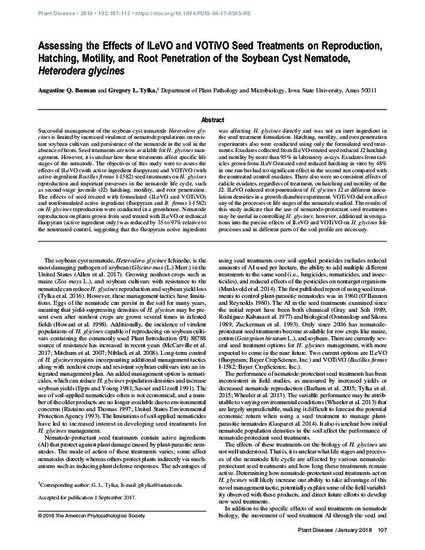
Successful management of the soybean cyst nematode Heterodera glycines is limited by increased virulence of nematode populations on resistant soybean cultivars and persistence of the nematode in the soil in the absence of hosts. Seed treatments are now available for H. glycines management. However, it is unclear how these treatments affect specific life stages of the nematode. The objectives of this study were to assess the effects of ILeVO (with active ingredient fluopyram) and VOTiVO (with active ingredient Bacillus firmus I-1582) seed treatments on H. glycines reproduction and important processes in the nematode life cycle, such as second-stage juvenile (J2) hatching, motility, and root penetration. The effects of seed treated with formulated (ILeVO and VOTiVO) and nonformulated active ingredient (fluopyram and B. firmus I-1582) on H. glycinesreproduction were conducted in a greenhouse. Nematode reproduction on plants grown from seed treated with ILeVO or technical fluopyram (active ingredient only) was reduced by 35 to 97% relative to the nontreated control, suggesting that the fluopyram active ingredient was affecting H. glycines directly and was not an inert ingredient in the seed treatment formulation. Hatching, motility, and root penetration experiments also were conducted using only the formulated seed treatments. Exudates collected from ILeVO-treated seed reduced J2 hatching and motility by more than 95% in laboratory assays. Exudates from radicles grown from ILeVO-treated seed reduced hatching in vitro by 48% in one run but had no significant effect in the second run compared with the nontreated control exudates. There also were no consistent effects of radicle exudates, regardless of treatment, on hatching and motility of the J2. ILeVO reduced root penetration of H. glycines J2 at different inoculation densities in a growth chamber experiment. VOTiVO did not affect any of the processes or life stages of the nematode studied. The results of this study indicate that the use of nematode-protectant seed treatments may be useful in controlling H. glycines; however, additional investigations into the precise effects of ILeVO and VOTiVO on H. glycines life processes and in different parts of the soil profile are necessary.
Available at: http://works.bepress.com/gregory-tylka/262/

This article is published as Beeman, Augustine Q., and Gregory L. Tylka. "Assessing the Effects of ILeVO and VOTiVO Seed Treatments on Reproduction, Hatching, Motility, and Root Penetration of the Soybean Cyst Nematode, Heterodera glycines." Plant Disease102, no. 1 (2018): 107-113. doi: 10.1094/PDIS-04-17-0585-RE. Posted with permission.